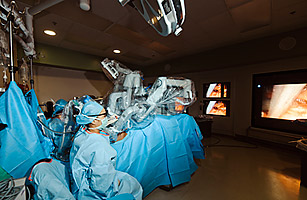
(2 of 4)
Within seven years, Menon's approach was the most common treatment for what is the second most frequently diagnosed nonskin cancer in America. The leading manufacturer of surgical robots, California-based Intuitive Surgical Inc., reports that roughly half of all prostate cancer surgeries in the U.S. in 2008 employed the company's da Vinci robotic system, which is now in use at more than 1,000 hospitals and clinics across the country and another 400 institutions around the world. Since then, the robot has continued to gain market share over both the open procedure pioneered by Walsh and the laparoscopic version of that operation.
Indeed, the robot revolution is moving so quickly that data goes stale even before it can be released. Menon offers a taste of that speed when he says that his hospital alone employs "nine going on 11" da Vinci machines.
Beyond the prostate, robot-assisted laparoscopy is being applied in all regions of the abdomen, from gall bladders to hysterectomies, from hernia repairs to liver resections. The abdomen is a lovely place to be a robot because surgeons can inflate the region like a balloon using carbon dioxide and then light the space like a film studio. But even in tighter spaces, cardiac surgeons, thoracic surgeons, orthopedic surgeons — even neurosurgeons — are joysticking their way through operations on hearts, throats, joints and spines.
Other robotic advances offer tantalizing glimpses of a mechanized medical future. By marrying high-tech imaging machinery to robotic tools, surgeons may journey into even more-remote, less accessible regions of the body with perfect surgical precision. (Imaging machines are already used to guide radiation beams with pinpoint accuracy, reducing damage to healthy tissue while permitting more intense therapies.) Perhaps one day there will be no need for a human surgeon. Researchers in artificial intelligence are working to design computers able to learn surgical techniques and then apply those patterns to steer robots through common operations. Add wireless technology, and maybe remote robots in underdeveloped parts of the world will perform surgery far from the humans or the supercomputers controlling them. Remote surgery has challenges: What happens if there's a power failure or the machine malfunctions? But several years ago, doctors in New York guided a robot in France through a simple gall bladder procedure.
Machines and Money
Something else is also going on inside this same Detroit operating suite. You can't see it, but it's every bit as real as the technology on display — and arguably more important. For here we have a collision between the engine of medical innovation and the runaway train of health care spending. Ponder the robotics revolution, and you begin to see how complex the effort to reform the U.S. health care industry is going to be.
The first thing to notice is that this hospital and these doctors are an example of what is right about American health care — not what is wrong. The Henry Ford Health System, which owns Henry Ford Hospital, is a well-run example of a large medical group practice. When the automobile magnate opened the hospital to serve the burgeoning Motor City in 1915, he sought advice from Mayo Clinic founder Dr. William Mayo, and today, Ford is the third largest nonuniversity academic group practice in the country, behind Mayo and the Cleveland Clinic.
The Ford family no longer owns or operates the hospital, though it is one of its largest benefactors. Its endowments and those of other grantors are well spent. Ford employs some 1,200 doctors, trains 500 medical students and delivers high-quality care to patients of every economic profile. Because the group offers a complete range of services, from checkups to hospice, Ford is able to coordinate treatment and keep costs below national averages. The system was an early adopter of computerized medical records; doctors are on salary rather than earning fees based on how many procedures they perform, so the staff have both the tools and the incentives to work efficiently. "This is absolutely the best model for health care," boasts system president and CEO Nancy Schlichting. "Having a fully integrated medical group, 1,200 doctors completely aligned — teaching, researching, delivering clinical care — is the greatest asset we have."
Part of being a thriving institution is recruiting first-rate staff and encouraging their innovations — just as Ford did with Menon. "Saying yes to very creative people is a good thing to do," Schlichting declares. That hunt for creativity sometimes takes her to unexpected places. Ford's surgeon in chief Scott Dulchavsky developed a remote ultrasound device tested aboard the International Space Station. Several years ago, Schlichting hired an executive to open a new Ford System hospital in suburban West Bloomfield, Mich. She wanted a beacon of wellness, not a sickness center, so instead of choosing a veteran hospital administrator, she picked an executive from the Ritz-Carlton hotel chain.